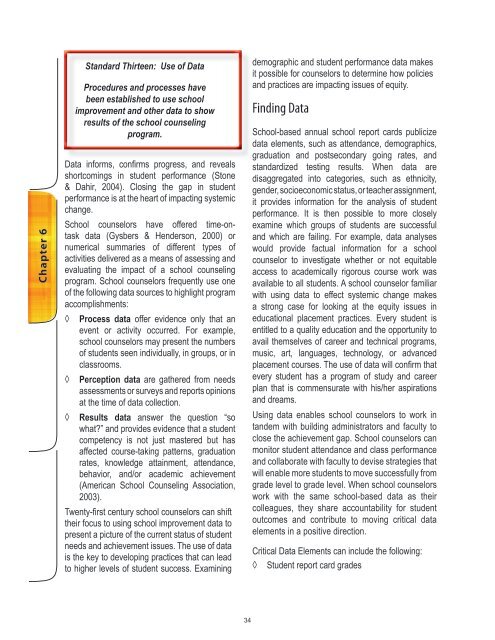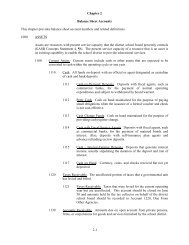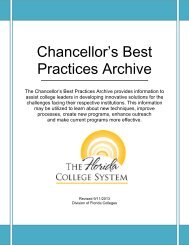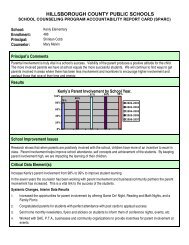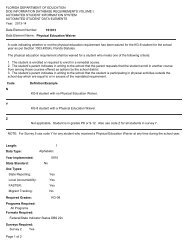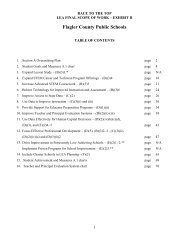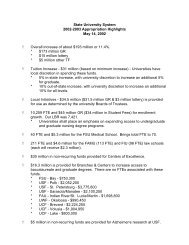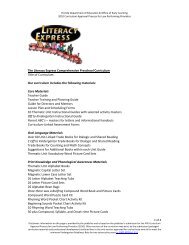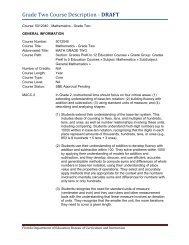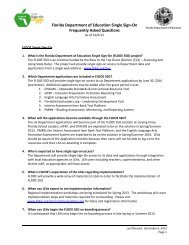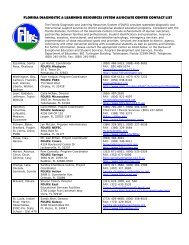Florida's School Counseling Framework - Florida Department of ...
Florida's School Counseling Framework - Florida Department of ...
Florida's School Counseling Framework - Florida Department of ...
You also want an ePaper? Increase the reach of your titles
YUMPU automatically turns print PDFs into web optimized ePapers that Google loves.
Chapter 6<br />
Standard Thirteen: Use <strong>of</strong> Data<br />
Procedures and processes have<br />
been established to use school<br />
improvement and other data to show<br />
results <strong>of</strong> the school counseling<br />
program.<br />
Data informs, confirms progress, and reveals<br />
shortcomings in student performance (Stone<br />
& Dahir, 2004). Closing the gap in student<br />
performance is at the heart <strong>of</strong> impacting systemic<br />
change.<br />
<strong>School</strong> counselors have <strong>of</strong>fered time-ontask<br />
data (Gysbers & Henderson, 2000) or<br />
numerical summaries <strong>of</strong> different types <strong>of</strong><br />
activities delivered as a means <strong>of</strong> assessing and<br />
evaluating the impact <strong>of</strong> a school counseling<br />
program. <strong>School</strong> counselors frequently use one<br />
<strong>of</strong> the following data sources to highlight program<br />
accomplishments:<br />
◊ Process data <strong>of</strong>fer evidence only that an<br />
event or activity occurred. For example,<br />
school counselors may present the numbers<br />
<strong>of</strong> students seen individually, in groups, or in<br />
classrooms.<br />
◊ Perception data are gathered from needs<br />
assessments or surveys and reports opinions<br />
at the time <strong>of</strong> data collection.<br />
◊ Results data answer the question “so<br />
what?” and provides evidence that a student<br />
competency is not just mastered but has<br />
affected course-taking patterns, graduation<br />
rates, knowledge attainment, attendance,<br />
behavior, and/or academic achievement<br />
(American <strong>School</strong> <strong>Counseling</strong> Association,<br />
2003).<br />
Twenty-first century school counselors can shift<br />
their focus to using school improvement data to<br />
present a picture <strong>of</strong> the current status <strong>of</strong> student<br />
needs and achievement issues. The use <strong>of</strong> data<br />
is the key to developing practices that can lead<br />
to higher levels <strong>of</strong> student success. Examining<br />
34<br />
demographic and student performance data makes<br />
it possible for counselors to determine how policies<br />
and practices are impacting issues <strong>of</strong> equity.<br />
Finding Data<br />
<strong>School</strong>-based annual school report cards publicize<br />
data elements, such as attendance, demographics,<br />
graduation and postsecondary going rates, and<br />
standardized testing results. When data are<br />
disaggregated into categories, such as ethnicity,<br />
gender, socioeconomic status, or teacher assignment,<br />
it provides information for the analysis <strong>of</strong> student<br />
performance. It is then possible to more closely<br />
examine which groups <strong>of</strong> students are successful<br />
and which are failing. For example, data analyses<br />
would provide factual information for a school<br />
counselor to investigate whether or not equitable<br />
access to academically rigorous course work was<br />
available to all students. A school counselor familiar<br />
with using data to effect systemic change makes<br />
a strong case for looking at the equity issues in<br />
educational placement practices. Every student is<br />
entitled to a quality education and the opportunity to<br />
avail themselves <strong>of</strong> career and technical programs,<br />
music, art, languages, technology, or advanced<br />
placement courses. The use <strong>of</strong> data will confirm that<br />
every student has a program <strong>of</strong> study and career<br />
plan that is commensurate with his/her aspirations<br />
and dreams.<br />
Using data enables school counselors to work in<br />
tandem with building administrators and faculty to<br />
close the achievement gap. <strong>School</strong> counselors can<br />
monitor student attendance and class performance<br />
and collaborate with faculty to devise strategies that<br />
will enable more students to move successfully from<br />
grade level to grade level. When school counselors<br />
work with the same school-based data as their<br />
colleagues, they share accountability for student<br />
outcomes and contribute to moving critical data<br />
elements in a positive direction.<br />
Critical Data Elements can include the following:<br />
◊ Student report card grades


